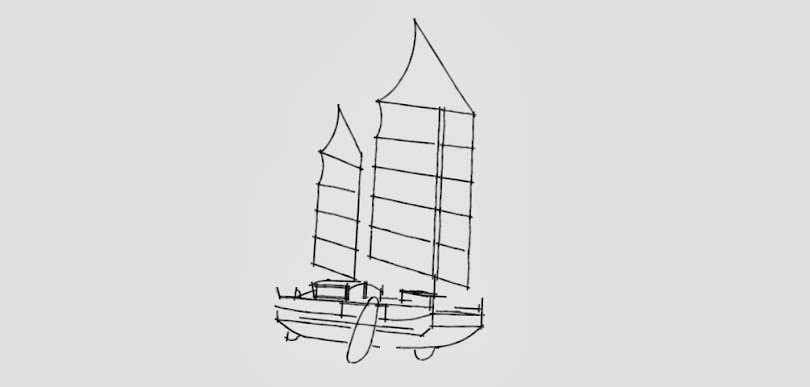 |
| Our first shot at SJR Ketch... Looks good, but doesn't feel right |
Second thoughts are ever wiser.
- Euripedes
Rethinking the Rig
In a previous post (Rig o' Morale), we introduced a variation on Slieve McGallister's SJR (Split Junk Rig), and the above ketch sailplan.
But a few points have been gnawing at me:
The mizzen (after sail) is most valuable to us as a maneuvering/weathercocking sail. Efficiency is welcome, of course, but not a prime consideration.
To leave anchor, for example, we raise mizzen, haul anchor, drift back on backed rudder and back mizzen to fall off reliably on our preferred tack, then raise main and sail off. No muss, no fuss, even with dangers close at hand. For sailing backward, again, we're backing sail and steering with rudder reversed. Occasionally, we'll leave the mizzen standing for a riding sail. We'll often drop the foresail, haul the mizzen close and drift, bow into wind of virtually any strength. This stops our headway, and eases motion for such chores as bailing the dory.
For each of these tasks, SLACKTIDE's flat-cut, low-lift, high drag mizzen has been perfect. Picturing these maneuvers with an extremely high-lift sail, with a large balance (area forward of the mast), jiblets cut full with a loose leech... well, it gives me pause. The high-lift can kick in abruptly, turning a backed sail into a driving one... a willawaw in close quarters could get tense. The large balance moves the mizzen's CE forward, reducing its positive effect aft. The jiblets are likely to flog in irons, which is hard on the sail and nerves... no problem for normal sailing, but... well... we're not normal!
If we want, therefore to go back to a good ol' unsplit, flat-cut mizzen, it reduces the balance by about 4ft, vacating considerable 'airspace' over the hull. Our sailplan is already snug, partly to avoid micro-burst surprises, and also as we don't like to handle very tall/heavy masts. So we want to fill that gap, at least to some extent.
Schooner rig (main mast at the forward end of the pilothouse) would do the trick, but the less efficient, after sail would be far bigger than it needs to be for our needs, and a relatively expensive tabernacle is required to deck-step the tall, free-standing mast. Also, the sheets sweep the cockpit (doable, but annoying), and we'd then want a driver (transom mounted sail) to improve balance, induce weather helm and take over maneuvering (more gear/handling/maintenance/expense). So we'll stick with ketch.
How to close the gap?
First way is to grow the mains'l, extending the battens from 18ft to 20ft. This is as long as one can get commercial lumber, in our parts. We generally prefer shorter battens for higher sail aspect ratio on a given height and less weather helm. But with this design's long mid-deck, we'll make the stretch.
Second, we'll reduce the mains'l balance to 25%. Slieve's first sail set in this proportion. He felt that more, up to 35% would improve performance (subsequent experiments confirmed this), and handling by reducing sheet stress. But even at 25%, the rig performed and handled well. We'll be rigging six part sheets, which will easily handle any extra sheet stress.
Another consideration is that our favored sailcloth comes in 60in width (5ft). At 25% balance, the jiblets can be made from one swathe, while the body can be made from three. Material efficiency!
As a trade-off, this arrangement sounds reasonable to us.
The result now looks like this:
 |
| Note the mizzen slot is gone. |
Since these changes, I'm breathing easier. That tight feeling I've gotten - trying to picture our first sailplan in an emergency exit, after dark in rising wind - it's gone away. Confidence is high. Without realizing it, that SJR in the aft position had been working at me.
Funny thing with design. We doesn't always know exactly what we want, or why. Things feel right, or not, and it may take a while to figure out why or why not. But it's almost always worth the effort.
And changing our minds on paper is cheap!


